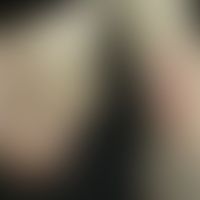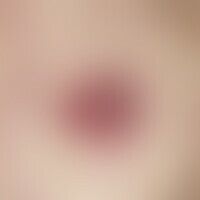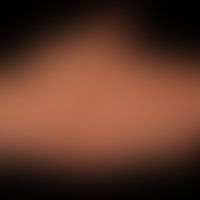Image diagnoses for "Plaque (raised surface > 1cm)"
570 results with 2866 images
Results forPlaque (raised surface > 1cm)

Keloid acne L73.0
Acne, keloid acne. stringy, coarse, brownish pigmented elevations in the chest area in a 24-year-old female patient on healed acne vulgaris. Medical history and clinic are pathognomonic.

Necrobiosis lipoidica L92.1
Necrobiosis lipoidica: 44-year-old woman. 10 years ago, fracture of the ankle joint with surgical treatment, for about 8 years beginning changes in the scars on the inner and outer ankle. Histologically, a necrobiosis lipoidica could be confirmed. On request, she was under constant diabetological control, since both previous pregnancies had been accompanied by insulin-dependent gestational diabetes.

Dyskeratosis follicularis Q82.8
Dyskeratosis follicularis: disseminated, chronically stationary, 0.1-0.2 cm in size, flatly elevated, moderately firm, non-itching, rough, red, scaly papules which unite at the top to form a blurred plaque; skin lesions have existed in varying degrees in this 53-year-old patient for several years.

Dermatitis exudative discoid lichenoid L98.8
Dermatitis exudative discoid lichenoid: reddish brown papules and plaques.

Melanosis neurocutanea Q03.8

Keratosis areolae mammae acquisita L 82
Keratosis areolae mammae acquisita in a patient with erythrodermal psoriasis.

Basal cell carcinoma superficial C44.L
Basal cell carcinoma, superficial, slow-growing, sharply defined, coin-sized, reddish-brownish, low-grade infiltrated plaque with a distinct edge accentuation of small, shiny nodules.

Pityriasis versicolor (overview) B36.0
Pityriasis versicolor: like scattered, irregularly configured, symptomless brown spots.

Bowen's disease D04.9
Bowen's disease:long-standing, slow-growing, sharply defined large-area, sometimes erosive, sometimes scaly, less symptomatic, sometimes slightly burning, red plaque.

Candida granuloma B37.2

Eosinophilic cellulitis L98.3
Cellulitis eosinophil: acute formation of circumscribed, large, sharply margined plaques The surface of the plaques may have an orange peel-like texture (see following figure)

Lichen planus (overview) L43.-
Lichen planus verrucosus: linearly arranged verrucous lichen planus; constant tormenting itching.

Acrodermatitis chronica atrophicans L90.4
Acrodermatitis chronica atrophicans: Initially flat, oedematous, livid red plaques; beginning transition to pronounced, flaccid atrophy with typical wrinkling of the skin (cigarette-paper phenomenon) and clearly translucent vein networks.

Vulvitis plasmacellularis N76.3
Vulvitis chronica circumscripta plamacellularis: Chronic, painful, deep red inflammation of the labia minora, urinary incontinence, malignancy can be excluded, but due to the symmetrical "imitation"-like distribution, it is clinically unlikely.

Primary cutaneous follicular lymphoma C82.6
Primary cutaneous follicular center lymphoma: coarse, painless, solid tumor, clearly elevated above the skin level, grown within 3 months, two smaller smooth, shiny tumors in the immediate vicinity of the arm.

Melanosis neurocutanea Q03.8
Melanosis neurocutanea, detailed picture with numerous congenital "oversized" melanocytic nevi.








